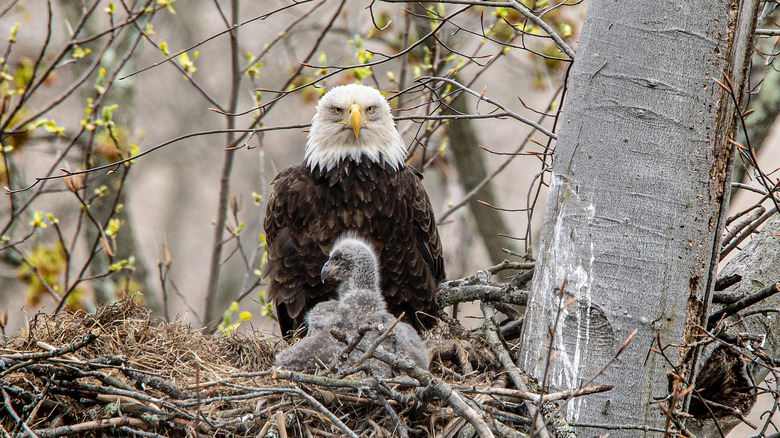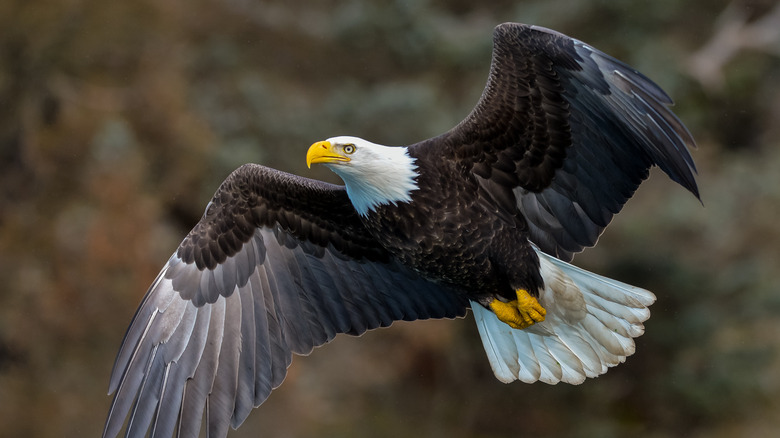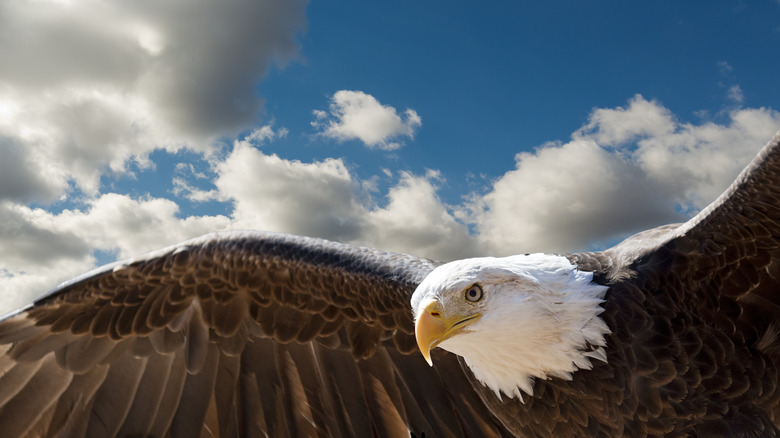How The Bald Eagle Survived Near Extinction
The bald eagle is one of the most magnificent creatures to swoop over the face of the earth. Soaring over North America like more of a national monument than a national emblem, this bird is often associated with triumph, resilience, and victory. Blessed with superhuman vision (per National Geographic Kids) and the second-largest wingspan in North America (via Avian Report), these keen feathered aviators dominate the skies and sea.
Their resilient nature is evident through the craftsmanship of their massive nests (which are designed to last for years), their ability to spot a rabbit from miles away, and their talent for swiftly swimming along the shoreline, using their wings to propel forward in a motion quite similar to the breaststroke (via Treehugger). But beneath their beaks and feathered wings lies an even deeper story of conquest that's truly unique. Here's how the bald eagle survived near extinction against all odds.
In 1973, the symbolic bald eagle was officially listed as endangered
According to Smithsonian Magazine, in 1782, when the massive bald eagle graced the face of the Great Seal of the United States and was named the United States' national bird, there were likely near 100,000 nesting across the countryside. The eagles soared well over other birds on the food chain, an aspect of life that would oddly prove detrimental as time wore on and humans casually destroyed wildlife habitats. Due in large part to habitat loss, over-hunting, and a toxic pesticide identified as DDT, the nesting eagle population nose-dived, reaching an all-time low in 1963 with approximately 487 left.
While the danger to the bald eagle was apparent in the early 1960s, CBS News reports that the Endangered Species Act would be another decade in the making. According to reports, that act, which was drafted into law in 1973, heralded the bald eagle as the face of wildlife preservation. Still, there were many obstacles ahead to overcome.
The Endangered Species Act protected the bald eagle from critical habitat loss
Audubon reports that the Endangered Species Act has made tremendous headway in the conservation of endangered species, boasting an awe-inspiring 99% success rate. Once listed, the bald eagle was protected from the loss of critical habitat and the harms of over-hunting.
Under the previously mentioned legislation, the bald eagle and other North American wildlife species on the list are afforded protection by land and sea. Hunting and/or harming a protected species is strictly prohibited, as is importing or exporting such animals (via World Wildlife Fund). However, the act calls upon the nation to do more than just protect. Officials are also tasked with repairing damage, restoring habitat areas, and enacting swift plans to recover the species.
Yet, even under this careful government and conservation watch, there was another threat to this glorious bird that could have wiped it right off the face of the earth forever.
A toxic pesticide known as DDT almost single-handedly drove the species into extinction
Remember earlier when we mentioned that being at the top of the food chain would prove almost fatal for this feathered friend? Well, that is due in large part to a toxic pesticide known as dichloro-diphenyl-trichloroethane, often abbreviated to DDT. The insecticide rose to fame in the mid-1900s, when it was widely used on crops and to fend off the plague, typhus, malaria, and yellow fever, all of which were rampantly spread through flea and lice populations at that time (via Britannica).
As the nation's fields were sprayed in a thick haze of the insecticide, the targeted pests built up an immunity, but the product proved fatal to their predators, many of whom were top-of-the-food-chain eaters with bodies that could not tolerate the toxic poison. Among these was the dwindling bald eagle, which was being given a fatal dose right when it needed a healthy boost (via the United States Environmental Protection Agency).
According to Britannica, DDT was a particularly treacherous insecticide because it seeped into the soil at vaster rates than expected, dousing fields and neighboring water supplies in 10-100 pounds per acre of product. It took a great deal of investigation to finally uncover the link between DDT and bald eagle reproductive failure. As it turns out, exposure to DDT caused a phenomenon of eggshell thinning in the species, which significantly stalled reproduction at a time when the opposite was necessary for preservation.
In 2007, the striking, white-headed bird soared right off the endangered species list
While the bald eagle is the national emblem of freedom often propped before the backdrop of a waving American flag, 2007 marks the year this bird officially became the face of resilience, bouncing back from a decades-long bout with near extinction (via American Bird Conservancy). The keen aviator with decidedly narrow eyes is now famous for something much more enduring than any national flag — the preservation of an entire species. According to Business Insider, the United States and Canada are in the midst of a critical 29% decline in bird populations over nearly half a century, a figure that reflects a loss of approximately 3 billion birds.
However, the bald eagle has surprisingly risen like a phoenix in the wake of despair and now exhibits a population of approximately 143,000 as of 2018 (per American Bird Conservancy). This is a remarkable uptick when compared to the all-time low of just 487 birds back in 1963 (via Smithsonian Magazine). What has made the bald eagle soar again? Furthermore, how can this success story impact other endangered bird species?
Important legislation continues to protect the bald eagle population
As a triumph over critical threats to survival, the bald eagle's story is far from over. Smithsonian Magazine reports that the national emblem now symbolizes more than three and a half decades worth of conservation efforts. While the species was removed from the federal endangered species list in 2007, the state of Vermont continued to struggle with breeding bald eagle pairs and only recently removed them from the national list in 2021. Moving forward, the regal birds will continue to live under protective legislation like the Bald & Golden Eagle Protection Act and the Migratory Bird Treaty Act.
But this story is not just about the bold eagle's future — it is also about the majestic bird's past. For through those narrow beady eyes reflects the story of similar bird species still on the brink of extinction (via American Bird Conservancy). Here, we behold a historic lesson about the unexpected effects of excess and toxins and our innate responsibility to protect all creatures on this earth and in its skies.





